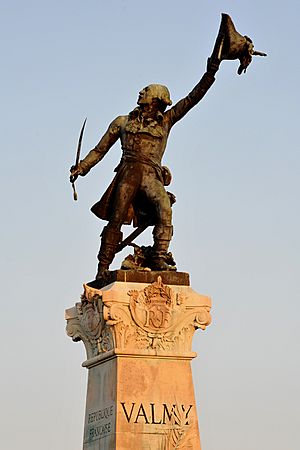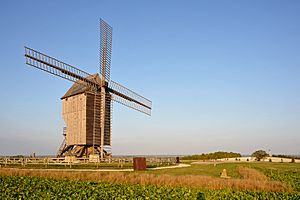Battle of Valmy facts for kids
Quick facts for kids Battle of Valmy |
|||||||
|---|---|---|---|---|---|---|---|
| Part of the War of the First Coalition | |||||||
 Painting of the Battle of Valmy by Horace Vernet from 1826. The white-uniformed infantry to the right are regulars while the blue-coated ranks to the left represent the citizen volunteers of 1791. The Moulin de Valmy was burnt on the orders of Kellermann on the day of the battle. |
|||||||
|
|||||||
| Belligerents | |||||||
| Commanders and leaders | |||||||
| Strength | |||||||
| 36,000 | 34,000 | ||||||
| Casualties and losses | |||||||
| ~300 | ~200 | ||||||
The Battle of Valmy was a very important battle during the French Revolution. It was the first big victory for the French army in the Revolutionary Wars. The battle happened on September 20, 1792. It took place near the village of Valmy in France.
Prussian troops, led by the Duke of Brunswick, were trying to march on Paris. But two French generals, François Kellermann and Charles Dumouriez, stopped them. This victory was a huge boost for the French Revolution. It showed that the new French government could stand up to powerful armies.
The win at Valmy helped the French decide to end the monarchy (rule by a king). They then created the French Republic. Many historians see the Battle of Valmy as one of the most important battles ever. It allowed the French Revolution to continue and change history.
Contents
Why the Battle Happened
As the French Revolution continued, other countries in Europe became worried. They feared that the idea of revolution would spread to their own lands. The War of the First Coalition was an effort by these countries to stop the revolution. They wanted to keep it only in France.
King Frederick William II of Prussia had support from Great Britain and the Austrian Empire. They sent the Duke of Brunswick with a large army towards Paris. At first, French troops struggled in the war. Enemy forces moved deep into France. Their goal was to bring back the old monarchy and end the Revolution.
The French commander, Charles Dumouriez, was planning to attack the Austrian Netherlands. But he had to change his plan because Paris was in danger. Another army, led by General François Kellermann, was ordered to join him. They would work together to defend France.
The French army had about 54,000 soldiers. Many of them were experienced soldiers from the old Royal Army. This included most of their cavalry and artillery (cannons). French artillery was known as the best in Europe. These skilled soldiers helped the newer volunteer troops. The enemy army, led by Brunswick, had about 84,000 soldiers. They were well-trained Prussian and Austrian troops. There were also soldiers from Hesse and French royalists who had left France.
The Battle Itself
The invading army quickly captured the towns of Longwy and Verdun. Then they moved towards Paris through the Forest of Argonne. Dumouriez stopped his attack on the Netherlands and turned his army around. He approached the enemy from behind them. Kellermann moved his army from Metz to help Dumouriez. They met near the village of Sainte-Menehould on September 19.
Now, the French forces were to the east of the Prussians. This meant they were behind the Prussian lines. The Prussians could have tried to march straight to Paris. But this would have left their supply lines open to attack. Bad weather and sickness among their troops also made things worse. So, Brunswick decided to turn back and fight the French.
The soldiers marched through heavy rain. Brunswick thought he could cut off Dumouriez's army. But just as the Prussians were almost in position, Kellermann moved his troops. He placed them on the slopes between Sainte-Menehould and Valmy. He set up his command around an old windmill. He quickly tore down the windmill so enemy spotters couldn't use it. His experienced artillery soldiers were ready on the ridge. This started what became known as the "Cannonade of Valmy."
Brunswick moved towards the French with about 34,000 troops. When they came out of the woods, a long-range cannon fight began. The French cannons were better. The Prussian soldiers tried to advance across the open ground under fire. But they couldn't make much progress.
As the Prussians hesitated, Kellermann had a key moment. He raised his hat and shouted, "Vive la Nation!" (Long Live the Nation!). All the French soldiers repeated the cry. This greatly boosted the French morale and scared the Prussians. The French troops also sang "La Marseillaise" and "Ça Ira". A loud cheer went up from the French line.
To everyone's surprise, Brunswick stopped the attack and left the battlefield. The Prussians went around the French positions from a distance. They began a quick retreat to the east. Both armies were about the same size. Kellermann had about 36,000 troops and 40 cannons. Brunswick had 34,000 troops and 54 cannons. Yet, when Brunswick retreated, only about 300 French and 200 Prussian soldiers were hurt.
Why the Prussians Left
The sudden end to the battle made the French very happy. People still wonder exactly why the Prussians pulled back. Most historians believe it was for a few reasons. The French had a strong defensive position. Also, more and more French volunteer soldiers were arriving. Their unexpected energy and spirit made the cautious Brunswick not want to risk losing many soldiers. Prussia also had to worry about a war in Poland at the same time.
Some people have suggested other secret reasons for the retreat. These ideas include a secret request from King Louis XVI to avoid a battle that might cost him his life. There were even rumors of bribery, supposedly paid with the French royal jewels. However, historians today say there is no strong proof of bribery.
The most likely reason is that Brunswick started with an aggressive plan. But he didn't have the courage to finish it when he faced a determined French army. Brunswick had actually been offered command of the French armies before the war. Some people who had left France used this to claim he was a traitor. In any case, the battle ended quickly. The French didn't chase the Prussians very hard. Brunswick's troops managed to retreat safely, even if it wasn't a glorious retreat.
What Happened Next
This battle was a turning point for the Prussian army. They faced food shortages and sickness as they retreated. Their retreat continued far past the Rhine River. French troops soon moved into Germany. They captured Mainz in October. Dumouriez then moved his army towards the Austrian Netherlands again. Kellermann successfully protected the front line at Metz.
Dumouriez's luck would change later. After another important victory in November 1792 at Jemappes, he struggled the next year. His army lost so many soldiers that he ended up joining the royalist side for the rest of his life. Kellermann, however, continued to have a long and successful military career. In 1808, Napoleon made him a noble, the Duke of Valmy.
Legacy of Valmy
In military history, the Battle of Valmy brought new ideas that changed warfare. It showed how important political messages, mind games (psychological warfare), and many excited citizen volunteers could be in "total war".
Over time, the battle became known as the first great victory for the armies of the French Revolution. In stories about the French Revolution, it is often shown as the first win for a "citizen army." This army was inspired by ideas of liberty and nationalism. Many thousands of volunteers did join the army. But at least half of the French forces were professional soldiers, especially in Kellermann's important artillery units. The French artillery also had an advantage with their modern Gribeauval gun system, which worked very well. But in popular belief, Valmy was a victory of ordinary citizens fighting for their country. Kellermann's cry and the soldiers singing "La Marseillaise" and "Ça Ira" during the fight became symbols of this.
On the day of the battle, the French government changed. The Legislative Assembly gave its power to the National Convention. Over the next two days, with the good news from Valmy, the new Convention leaders ended the monarchy. They then announced the French Republic. The victory gave much-needed pride to the new French state. It also inspired them for many years to come. Many people at the time thought it was a miracle for France. They saw it as a big defeat for one of Europe's strongest armies. Scholars still consider it one of the most important battles in military history.
The Prussians themselves understood how important the battle was. It wasn't just a setback in the war. It was a big step forward for the Revolution. The German writer Johann Wolfgang von Goethe was with the Prussian army at the battle. He later wrote that his friends were very sad. He had often cheered them up with clever sayings. But this time, his only comfort was, "Here and today, a new time in the history of the world has begun, and you can boast you were present at its birth."



